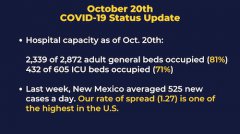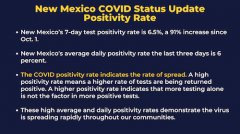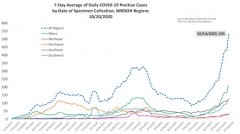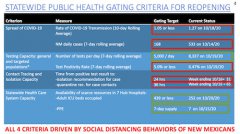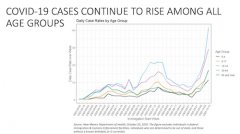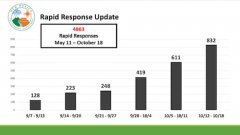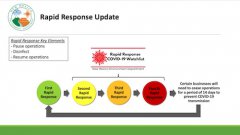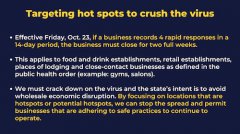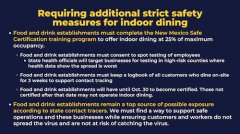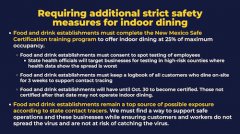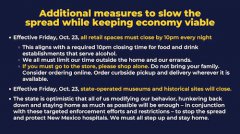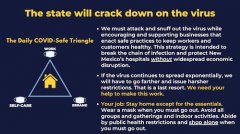MLG102020
MLG102020
MLG102020
MLG102020
MLG102020
MLG102020
MLG102020
MLG102020
MLG102020
MLG102020
MLG102020
MLG102020
MLG102020
After some minor technical difficulties, Governor Michelle Lujan Grisham started the COVID-related update on October 20, 2020 and immediately introduced Dr. David Scrace, Secretary of Health and Human Services, for updated COVID-19 information. Also joining via Zoom was James Kenney, Secretary of the New Mexico Environment Department, and Lieutenant Governor Howie Morales.
"One of the problems is that we are most full in Albuquerque, and that's a referral center for the whole state," Scrase said.
Currently the rate of spread in New Mexico is 1.27, one of the highest in the United States.
Scrase reviewed the 7-day average number of cases and said the current upward trend is "chilling." He said that "a lot of us thought that the peak at the end of April/early May was large, and then in July. We are now doubling any amount of cases that we have ever had before, with increases from each part of the state."
"This is the curve that bothers me the most and has bothered me the most over the past week," Scrase said as he showed the statistics per age group. "Each one of these age groups has set a new record."
"It isn't so much where we are now," Scrase said, "but where we are going to be in 2 to 3 or even 4 weeks.
"We're now missing in 5 of the 8 criteria," he said. "Our contact tracing has finally experienced difficulty catching up with all the cases."
Scrase said hospitals still have room, but there's a concern about capacity in the next few weeks. "Remember to continue to go for your needed care," he said. "This doesn't mean don't go to the hospital if you have a scheduled test or procedure. It just means that when you're not seeking medical care, do your best to stay at home."
Kenney talked about what's new in Rapid Response. A key change is the Rapid Response COVID-19 watchlist. Once a business goes through their second rapid response they will appear on the watchlist. This list will be published for the public to know which businesses have high numbers. "While the goal is to stay home, if you do need to go out to one of these businesses you will have the tools as to where COIVD is in the workplace, in your community."
Some businesses will need to cease operations if they have four rapid responses within a 14 day period. These include restaurants, salons, and gyms.
Grisham said the new measures are to be considered a crackdown, not a shutdown. There are things to consider behind the decisions that are being made.
"One, New Mexico has 1/3 less hospital beds per capita than any other state in the country," she said. Grisham said "we want to be able to service regular hospital visits from trauma to mothers giving birth, so New Mexicans need to get ahead of the virus.
"Two, the number of cases as you saw is exponential. There were some days over the last several where our positivity rate was 8," she said. "And third, we want to make sure that as we're protecting our healthcare resources and we're protecting New Mexicans, that we're saving lives in that design." Grisham said this is all while trying to get to a state of normalcy.
As of October 23, if a business records 4 rapid responses in a 14 day period, it will be closed down for two weeks to get everything safe again. "Businesses aren't spreading the virus," Grisham said. "People coming to the businesses are spreading the virus." Focusing on locations and high risk communities will help focus on mitigating the spread without shutting down the wider economy.
Among the additional "crackdown" measures is the requirement of additional safety measures. This means those places with indoor dining MUST complete the New Mexico Safe Certified program in order to serve people. Previously those without such a certification could operate at a lower capacity.
Those businesses must also allow for spot testing of employees. This particularly affects those working in high risk counties where spread is the worst.
An on-site log book is also needed, which if kept for at least three weeks at a time can aid in contact tracing.
"These strict COVID-safe practices are the prudent way forward," Grisham said. The latest revision to the public health order also includes closing businesses by 10pm.
"We are optimistic," Grisham said. "We are in a very difficult place currently. The virus is winning." She said these efforts will make a difference - as long as New Mexicans support them.
Just like last week, Grisham is asking folks to limit their daily trips to three or less. "Don't go more than three places a day. If you have the opportunity to go nowhere then the virus can't use you as a vehicle to move around."
"Our North Star is still saving lives and making sure the health care system is not overrun," she said. "[The virus] really is spreading exponentially."
"By the information presented, now is not a time to panic but a time to be prepared," Morales said. "From the very beginning the goal was to keep each of us safe. I want to remind every single person that we can get there once again."
When asked about the theory that only the vulnerable should remain at home in an effort to bolster the economy and limit spread, Grisham said it's not an option here in New Mexico where 1 in 3 people are vulnerable. "We also lost an 18 year old in Southeast New Mexico. The virus doesn't care if you have underlying conditions," she said. "And seniors need prescriptions and food." Grisham said some seniors still go to work, too. Grisham thinks it oversimplifies things to believe that only the vulnerable need to shield themselves.
"Two things," Scrase said, "One is the elderly aren't just vulnerable in and of themselves. Some risk factors are more common under the age of 65." He said the other factor is the large number of multigenerational families in the state. "Sectioning them off would disrupt a huge percentage of our families, and they might have a child or grandchild in and out of the house."
For further information and resources, please refer to the following:
New Mexico Crisis and Access Line
Updated COVID-19 information
New Mexico Early Childhood and Care Department
New Mexico Environment Department
New Mexico Education Department
New Mexico Department of Workforce Solutions
